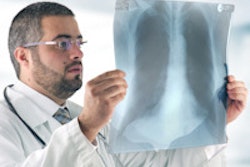Radiology residents are of two minds when it comes to night call, according to the results of a new survey in Academic Radiology. They want the peace of mind that comes with knowing an attending radiologist is on duty overnight to help navigate tough cases, but they also hunger for the freedom to make a "hot call" on tough cases without help.
The survey queried 146 radiology residents in six large academic institutions: three with 24/7 on-call attending physicians, and three with residents who read overnight studies on their own. Residents with 24/7 on-call coverage dictated fewer than half of their own radiology reports, compared with more than 80% of reports read in centers without full-time attending radiologists, reported the study authors from the University of Cincinnati, the University of Michigan, and four other institutions.
In terms of learning, residents in facilities with full-time attending coverage valued feedback more positively than those at centers without coverage. But residents with overnight attending coverage rated their autonomy lower, according to the authors.
And the most strident views seemed to come from those resisting the implementation of overnight attending coverage, perhaps fearing the loss of autonomy and an inferior educational experience that would result, wrote lead author Dr. Jannette Collins and colleagues (Acad Radiol, April 12, 2014).
"The general perception in talking to residents around the country is that they have negative feelings about having faculty in-house all night," said Collins, the chair of radiology at the University of Cincinnati College of Medicine, in an interview with AuntMinnie.com. On the other hand, "some residents see advantages to having a faculty person in-house all night."
Growing presence
Attending 24/7/365 coverage is a hit-or-miss phenomenon in the U.S., but the trend is up. A 2007 survey of radiology department chairs found that just 10% of radiology departments had full attending 24/7/365 coverage -- and concluded that having overnight attendings wasn't the standard of practice.
Surveys show that the percentage of facilities with such comprehensive coverage varied from year to year, but generally grew from 4% in 2004 to 14% in 2005, fell to 12% in 2009, and bounced up to 20% in 2012, with an additional 7.5% of surveyed departments planning to implement the coverage during 2013.
The reasons for hiring overnight attendings include a desire for faster report turnaround and also past reports of major reporting discrepancies between attendings and residents, as well as a desire to avoid potential turf battles in emergency imaging by having radiology staff available, Collins and colleagues wrote.
Arguments against the expanded role of the radiology attending include the lack of recent evidence of significant discrepancies between resident and attending reads, and residents' general feelings of being deprived of valuable professional experiences, the authors wrote.
A tale of 2 environments
The 11-item online survey (SurveyMonkey) compared programs with and without continuous attending radiologist coverage, from several viewpoints regarding resident perceptions of their call experience, including the following:
- Educational value
- Comfort levels with overnight duties
- Role as primary contact for referring physicians
- Degree of autonomy
- Adequacy of faculty feedback
- Whether supervision encouraged resident candidates to apply for the program
- Residents' ability to research questions during initial review of radiology exams
Researchers counted the volume of exams dictated and the percentage dictated by residents, as well as report turnaround times.
Full-time faculty equivalents ranged from 32 to 118 per center, and the mean exam volume over the study period was 40,090 exams. Three sites had continuous coverage and three did not, though two of the sites had continuous coverage over one-week periods, followed by two weeks without, Collins and colleagues noted. Two to five residents were on call each night at each center.
More autonomy alone, but slower service
The three sites with continuous in-house coverage had 64,258 (46%) of reports dictated by attendings from 8:00 p.m. to 8:00 a.m., compared with 82,500 (81%) of exams dictated by residents at the sites without continuous coverage, the researchers reported. Overall, 62% of 143 residents said they were always the primary contact for referring physicians during night call.
Residents were significantly likelier to be the primary contact for referring clinicians, with more experienced residents reporting that they were more often the primary contact, Collins and colleagues wrote. But experience level accounted for just 8% of the variance in this survey item, and coverage did not have a significant effect, they wrote.
Senior residents said they were more comfortable performing overnight duties than less experienced residents. But comfort levels once again had little to do with whether a facility had coverage, suggesting that residents learning on their own became confident more rapidly. And the impact of coverage on the residents' overall view of their experience at night did not vary by training level, according to the study authors.
Of the eight survey questions, three reached statistical significance between sites that had continuous overnight coverage sites and those that didn't. Sites with continuous coverage rated faculty feedback more positively (mean score of 3.8 on a scale of 1 to 5) versus a score of 3.3 for centers without continuous attending coverage.
However, residents with continuous coverage rated their autonomy lower (mean 3.6 versus 4.5 for centers without continuous coverage). And, sites with continuous coverage also rated their overall educational experience more negatively (mean 3.6) than centers without such coverage (mean 4.2) (all p < 0.05).
As for reporting, turnaround times were faster in programs with continuous coverage (mean 1.7 hours) compared with those without (mean 9.1 hours). At the three sites with continuous coverage, the longest interval was 3.5 hours (1 hour for emergency examinations), versus a longest interval of 15 hours at sites without continuous coverage, the authors wrote.
Bemoaning a lack of autonomy
Many of the comments submitted along with the survey complained about the lack of autonomy at centers with attending coverage. One comment reported that residents can become careless if they know a second set of eyes will look at a study, and that there's a sense of satisfaction making a hot call.
But stress levels are lower, especially for junior residents, and having staff available for tough cases and immediate feedback is valued.
However, comments from residents at institutions without night coverage came out strongly in opposition to implementing it in their facilities, the study team wrote. What's behind the dissatisfaction with attendings? Collins had a few thoughts on the matter.
"There's some inconsistency in how much feedback residents are getting at night; they may or may not be sitting in the same room with the radiologist," she said. "The radiologist opens up the exam that has been dictated by a resident and may sign off on it without discussing the exam with the resident. And that can be OK ... but if it happens a lot and there's not much interaction, then residents don't see that as an enhancement to their educational experience."
A few limitations to the study included residents with continuous coverage being more likely to complete the survey, the authors noted. Also, residents' perceptions of the value of all-night in-house radiologist coverage were likely biased by the type of program they chose for themselves, assuming that they considered this factor before applying. Inclusion of more centers and more respondents would improve the reliability of the results, the study team wrote.
The switch in Cincinnati
A few years ago Collins' facility switched to full coverage despite studies showing that residents' performance was on par with that of attendings. But the hospital wanted to do it, "and they put enough pressure on us that we did it," Collins said. "Now we're just trying to make the best of it."
The new system has plenty of advantages and disadvantages, she said, including the fact that it costs money and extra personnel need to be hired one way or another.
Then there are issues with not having a specialist radiologist read a study because three generalists have been hired to do the work at night.
"Part of the advantage of being academic compared with a community private practice is that we're subspecialists, so we don't have that advantage at night anymore if we have generalists do our reads," Collins said. "And residents are sitting down with generalists instead of subspecialists."



















